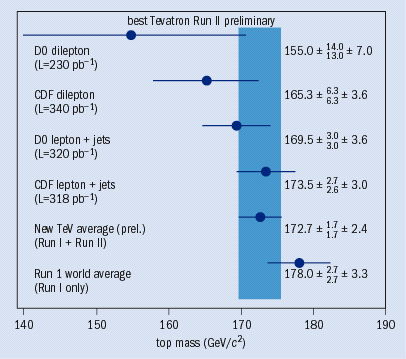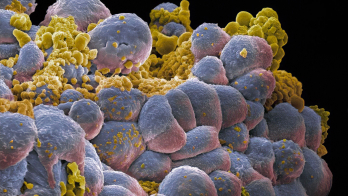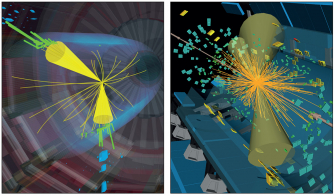The HCP2005 Symposium, held in the Swiss Alps, discussed the latest results from the Tevatron and the prospect that the LHC will open new scientific frontiers.
In the early 1980s, CERN initiated the pbar p Collider Workshop series with the aim of communicating and synthesizing the latest results from hadron collider experiments – most recently the Collider Detector at Fermilab (CDF), and the D0 experiment at the Tevatron at Fermilab. This year, with the projected commissioning of CERN’s Large Hadron Collider (LHC) in 2007 and the subsequent transfer of physics activities, the series was merged with the LHC Symposium that is devoted to preparing LHC experiments, and renamed the Hadron Collider Physics (HCP) Symposium. HCP2005 was organized by CERN and the Swiss Institute for Particle Physics (CHIPP), and was held in Les Diablerets, Switzerland, on 4-9 July. About 150 participants attended from the Tevatron and LHC experiments.

Ralph Eichler, the director of the Paul Scherrer Institute, gave a welcoming address. This was followed by Georg Weiglein from the Institute for Particle Physics Phenomenology, Durham, who presented an introductory theoretical overview of the role of hadron colliders in studying the Higgs sector of the Standard Model. The first major session was then devoted to machine and experimental studies at the Tevatron and LHC. David McGinnis of Fermilab described current and prospective operations at the Tevatron, where the CDF and D0 experiments are operating well and an integrated luminosity exceeding 1 fb-1 has already been delivered to each experiment. CERN’s Lyn Evans outlined the progress made in building the LHC, and representatives from each of the LHC experiments described the advanced construction status of the detectors, as well as the new phase of detector integration and commissioning.
Directions for physics
With the goal of maximizing the shared experience of the Tevatron and LHC communities, the symposium was then organized around the key physics directions of hadron-collider research. Each of the physics sessions was introduced by a theorist, who gave an overview of the subject, followed by speakers from the Tevatron and LHC experiments. Sessions were also held on experimental issues such as particle identification, or tracking and b-tagging, in which experts from both communities could present their solutions and exchange ideas.
The first physics session was on the subject of quantum chromodynamics (QCD). It opened with a talk by Keith Ellis from Fermilab on the status and limitations of next-to-leading-order (NLO) and next-to-next-to-leading-order (NNLO) theoretical calculations, together with calculations planned to match experimental “wish lists”. The experimental talks described the wealth of data that is becoming available from CDF and D0. There were also several talks about identifying and calibrating jets at the Tevatron and in future at the LHC.
A complementary session dealt with electroweak physics, a field in which some surprises may emerge. Ulrich Baur of the State University of New York presented the status of Standard Model fits and available calculations. This was followed by talks on production measurements of single-vector bosons and vector boson pairs.
The LHC is expected to open new frontiers beyond the Standard Model, so a major session was devoted to existing and future direct searches for new physics. This could be supersymmetry or something more exotic, and might even appear in small deviations in rare B-meson decays measured at the LHCb experiment. No hints of new physics have been found at the Tevatron. However, Anna Goussiou from the University of Notre Dame showed that even with reduced luminosity expectations for the final Run II data sample, the CDF and D0 experiments maintain a non-negligible potential for finding “evidence” of a Higgs boson in the low-mass range, where identification is most difficult for the LHC experiments.
Not so long ago, precision b-quark physics was considered to be almost impossible at hadron colliders. However, thanks to dedicated triggers and excellent tracking capabilities, the Tevatron experiments have world-class results that are in many cases comparable to those from the b-factories. Furthermore, CDF and D0 have a monopoly in studies of the BS sector. An important request from the theoretical community, which was emphasized in the talk by Luca Silvestrini from INFN/Roma, is for measurements of BS mixing, in particular the parameters ΓS and ΔmS. Guillelmo Gomez-Ceballos of the Instituto de Fisica de Cantabria presented results from the CDF effort on that topic. There is no quantitative measurement so far, but, with all of the analysis machinery in place, the whole region of ΔmS that is predicted by the mixing triangle can be covered as soon as sufficient data are available. If surprises arise and the value is larger than expected, the LHCb experiment will discover and/or measure with extreme precision this missing piece of the Cabibbo-Kobayashi-Maskawa puzzle.
The results from the Relativistic Heavy Ion Collider (RHIC) at Brookhaven and expectations from the ALICE experiment at the LHC dominated the session on heavy-ion physics. However, talks about CMS and ATLAS, the two general-purpose detectors at the LHC, showed that they will have a vital role in many aspects of heavy-ion physics; for example, in measuring high-pT jet production.
Top quark results
The last major physics session was dedicated to the top quark. CERN’s Fabio Maltoni highlighted the improved experimental conditions that are available at the LHC compared with the Tevatron, and stressed the importance of measuring the properties of the top quark to try to explain its large mass. Tomonobu Tomura of Tsukuba presented the latest mass measurements from CDF and D0 (figure 1), including CDF’s new measurement of 174.5+2.7-2.6 (stat.) ± 3.0 (sys.) GeV, based on a two-dimensional template method. While the preliminary Tevatron average for the top mass is 174.3 ± 2.0 (stat.) ± 2.8 (sys.) GeV, by the end of Run II the Tevatron experiments are expected to measure the mass with a precision better than ±2 GeV. The search for single-top production, as well as preliminary measurements of the ttbar production cross-section, were also described. Arnulf Quadt of Bonn presented the measurements of some t-quark decay properties (for example, the W-helicity) and searches for rare t-quark decay modes. Presentations by the CMS and ATLAS collaborations underlined the rich experimental programme that is expected in the future.

The physics sessions were interrupted by two sessions about preparations for the LHC. A key issue will be lepton identification. One session was devoted to the results and pitfalls from the Tevatron experience, and ended with status talks on the hardware and reconstruction aspects of the LHC experiments. The results seem encouraging, even if experience shows that the real answer only comes under running conditions. A natural follow-up to the b-physics session was a discussion on tracking and b-tagging. The lesson from the Tevatron has been positive and the LHC collaborations seem to be aware of that. The overall computing strategy and preparations for analysing the LHC experiments were widely presented and discussed at the end of the session.
A special guest at the symposium was Fermilab’s Alvin Tollestrup. Tollestrup played a crucial role in the machine, detector and analysis activities that led to the discovery 10 years ago of the top quark by the CDF and D0 experiments. In an inspiring presentation, he talked about “the trail to the top”, leading to the discovery of the top quark and the ideas that were behind it. Many saw this talk as Tollestrup’s way of passing the baton to a younger generation. He also reminisced about a time when particle physics was on a smaller scale, and he stressed the evolution of experimental techniques in particle physics and their consequences.
The theoretical and experimental summaries of the symposium were given by Pierre Binétruy of the Laboratoire d’Astroparticule et Cosmologie (APC) in Paris, and John Womersley of Fermilab and the US Department of Energy. Binétruy stressed the important role of the LHC programme during the coming years. Womersley placed the results presented at the conference in the context of the rapidly evolving jigsaw puzzle of the Standard Model of electroweak and strong interactions, with its extensions and future possible surprises.
Holding the conference in a remote alpine location was a challenge. However, the organizing committee from CERN and CHIPP, the secretaries from CMS and ATLAS (Nadejda Bogolioubova and
Jodie Hallman) and the hotel staff made it a success. The only unpredictable factor, the weather, played foul. Although luck held during the welcome drink and an Alpine horn concert, it was mostly raining, and a dinner at 3000 m altitude in the glacier restaurant was immersed in cloud. Only those participants who remained an extra day discovered the beauty of Les Diablerets in brilliant sunshine.
The next meeting of the series will be hosted by Duke University in May 2006, and in summer 2007 the meeting will be hosted by INFN Pisa in or near the town of Pisa.








